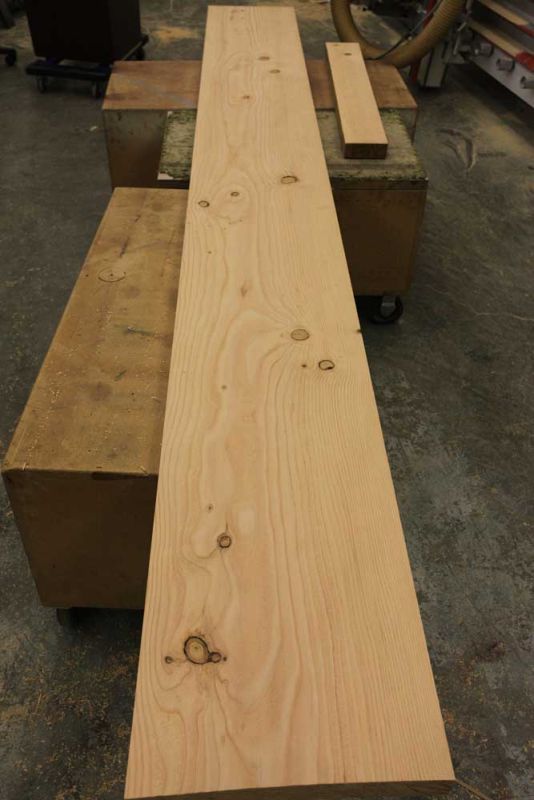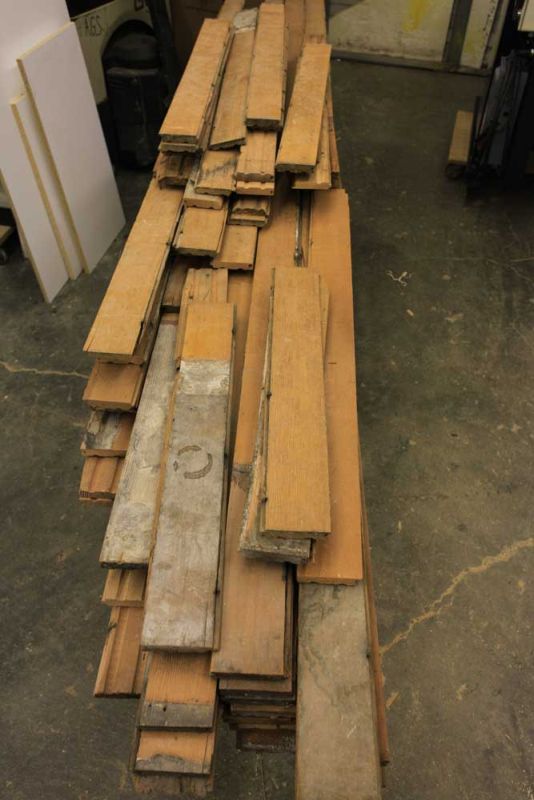Flattening a Long Plank: Planer Versus CNC
CNC wins the argument, but we have fun getting there. December 6, 2012
Question
Owner got a call the other day from one of the contractors we do work for. Customer (green designer) wants this fir plank 18" x 12' x 3" thick made into a bar top. This is basically framing lumber with loose knots, etc. He was looking for a shop with 16"+ planer to flatten the cup and twist out and then plane to size. Owner could not think of anyone to call. I told him to have contractor bring it by and I would flatten it on CNC machine.
Plank is now at shop, but owner wants to run it through planer on backer board to flatten. He says he is going to glue shims between backer and plank. I told him he would have problems with knots and the size.
Has anyone had good luck running this size board through planer to flatten? I have had limited luck running smaller pieces this way, but never thought of trying anything larger, and neither has the owner. I told him I still thought the CNC would be a better choice since I have done this before.
Forum Responses
(Solid Wood Machining Forum)
From contributor J:
The wood planer - sure, why not? The backer board trick sounds a little weird, but it should work. A wide jointer along with a planer is what I would use. Lumber mills typically have two-headed planers that do the same thing. Give 'em a call and ask if they'll dress a timber for you. The knots are no problem provided they're solid. They dull the knives a bit but that's part of the game.
CNC? I'm sorry but that sounds ridiculous. How do you suppose woodworkers ever got by without CNC?
From the original questioner:
If we had the large jointer that would be the way to go. We do not, though, and for a one off, to me, being an old school wood machining guy turned CNC guy, the back board and shimming sounds doable, but I would have it done on the CNC well before he glued on all his shims. What's the big deal? You put it on the table and run the 4" spoil board cutter over it a few times. Just shove a couple of shims in the corners to level out the twist. The rotary cutting action also tears out the grain less, although it is fuzzy. You do not have to worry as much with the grain going this way and that way.
Changing those planer knives out will suck either way because we will still have to take it down on the planer. Gotta love those designers and their knots. We have to glue them in too - they are all loose.
From Professor Gene Wengert, Sawing and Drying Forum technical advisor:
A planer is actually a thickness control device and is not very good at flattening lumber, especially lengthwise distortions like twist (as you mention). The planer will take out cup at times, but the pressure can also cause cupped pieces to crack when the rollers and pressure bar try to push the lumber flat. This cracking is more likely with eastern white pine and other low density, brittle woods, and with wide pieces.
Jointers or even a CNC can be used to flatten both across the piece and along the length (including twist). The idea of shims may indeed work for cup.
From contributor M:
What always amazes me is how someone asks you to do something, because you are the expert, then tries to tell you how to do it. Use the CNC.
From contributor E:
I think the easiest solution would be flattening on a wide enough jointer and then planing to thickness. As you don't have the machinery big enough, I think the CNC sounds like the way to go. Building a sled that big, shimming, and gluing will take a half a day. Once you get a side flat, it can go through the planer to hit the other side.
From contributor R:
We have a top and bottom carpet type planer that would flatten that out reasonably well. It requires several passes and depending on the twist, you may end up pretty thin. Sorry - I wouldn't put the effort into jointers or CNC machines because construction grade lumber is just that, construction grade, and it is not going to stay flat.
From contributor E:
Misconception here about the CNC requiring effort. Five minutes to put it up on the table, couple minutes to write a program, watch it go back and forth for another five minutes, and you are done. Not even worth talking about another method, if you have a big enough machine to handle it. No wearing out your back on the jointer, even if it were big enough. Flip it, and take most of the twist on the other side out with the CNC as well, then go to the widebelt or planer for finishing.
From contributor J:
I must be living in another century. I have both a 16" jointer and a 20" planer but no CNC (especially one with a 12' bed).
From contributor Y:
The ideal machine for this application is a double surface (or a carpet type double planer). Basically, the feed system uses spring loaded fingers which cushion the board as it passes over the bottom head, much like a jointer, and then a sectional feed roll takes it through the thicknessing top head. The result is a uniform timber without a twist.
From Professor Gene Wengert, Sawing and Drying Forum technical advisor:
A machine like the one mentioned above has perhaps 4' to 5' that it is trying to control thickness and warp. It will not control longer (or lengthwise) warp as well as a CNC or a jointer as discussed in previous postings. As twist is usually a longer type warp, I question how well it will do on twist.
From contributor T:
Gene, I have a machine like this, and you are correct. It will not take out twist on a long board.
From contributor R:
That is the machine I have also, as referred to before in an earlier post. Gene, you are correct in the 4' infeed section to the first bottom head, but what does a jointer have? Yes, you can manipulate the material on the jointer to work the twist out and even some warp, but over 12', what are you left with in thickness? I promise that planer will take most if not all twist and a reasonable amount of warp out, and it would be more than satisfactory, if not perfect, for a bar top. It would be my choice without hesitation over a CNC router or a jointer, all of which I have.
From contributor B:
I vote for the CNC. Fifteen minutes start to finish and dead flat.
From contributor J:
Come on now... 15 minutes of CNC time? Of course your CNC (with a 12' bed) is standing idle and just waiting for some guy to walk in to have his construction timber straightened out.
I'm curious. What's the going rate for a fifteen minute CNC job? (Is there such a thing?) Do you suppose employing a high tech CNC machine to surface construction grade lumber is economically viable? Should lumber mills replace all their surfacing equipment with CNC driven router motors and bits?
Are we talking reality here or just what could be? Because if we're talking reality, I'm quite sure either you or I would just call the lumber mill and order what we want and it would arrive on a truck. If it's not sufficiently straight and flat, it goes back the same way.
From contributor E:
Time out. The guy is sitting there with an idle CNC and a planer! He's asking the better of two options - CNC versus shimming onto a sled to go through the planer. He's not going to invest tens of thousands of dollars in a new double headed planer. Nor is he going to tell the guy to order different material. He could do that, but it wasn't the question.
He's sitting there with a slab of wood (well, likely he's already flattened it by now), and has done this type of thing before. So it's certainly feasible. It's just a question of whether it's practical to try and push it through the planer on an extra large sled? Or stick with what he's done before and use his CNC.
From Professor Gene Wengert, forum technical advisor:
Contributor B is indeed correct. It would take no time at all to program the CNC for a flattening job on one face. Note this is not construction lumber, but a bar top. As such, only the top needs to be flattened to take out the twist. I believe that 15 minutes will indeed do the job. The original poster has a CNC machine, so the cost is not an issue really.
From contributor J:
Contributor E is right of course. Since I neither own nor operate a CNC machine, I suppose I'm totally unqualified to respond in any way (sorry). All I know is that the last time I asked someone to bid a simple CNC job for me, it was several thousand dollars and at least a couple hundred per hour. I wouldn't dare ask him to straighten out a rough construction timber.
From the original questioner:
Thanks for the responses. Yes, I finished that board. Took me 45 minutes, though, because I had to index the spoil board cutter, slow down for the knots, and surface both sides. I took it to final thickness, though, and we did not have to index the planer knives after trashing them on the knots. $250.00.
Here is finished board. To be fair, we did rip it to size, and we need to run it through sander for the 250. It was flat within .5mm after surfacing and appears to not have moved after sitting a couple of days. The knots did not tear out too much either.

Click here for higher quality, full size image
Here is our next reclaim project. We need to turn this cart load of fir flooring into kitchen doors. Same client. Check out the cement on the ends.

Click here for higher quality, full size image

